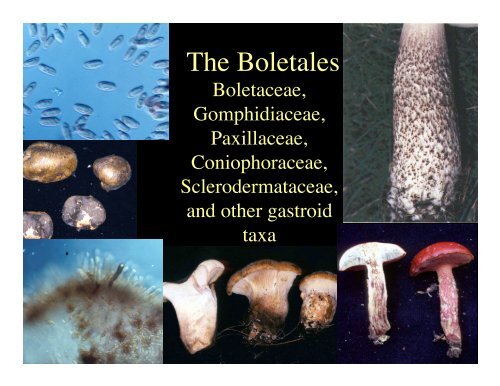Create successful ePaper yourself
Turn your PDF publications into a flip-book with our unique Google optimized e-Paper software.
<strong>The</strong> <strong>Boletales</strong><br />
Boletaceae,<br />
Gomphidiaceae,<br />
Paxillaceae,<br />
Coniophoraceae,<br />
Sclerodermataceae,<br />
and other gastroid<br />
taxa
Characteristics of the “Boletaceae”<br />
(polyphyletic family)<br />
• Fleshy tubed mushrooms, or gilled with<br />
interwoven tube-like gills<br />
• Moderate to large sized with bun-shaped pileus<br />
• Divergent gill(tube) trama<br />
• Often bruising: blue, red, black or green (pulvinic<br />
acids, and others)<br />
• Usually with elongate spores<br />
• Usually ectomycorrhizal
Typical bolete spores
Boletoid clade<br />
(Boletus, Leccium,<br />
Tylopilus, Pulveroboletus, and<br />
others)<br />
Paxillus and Chalciporus<br />
Coniophoraceae and wood decaying Paxillaceae<br />
Gyrodontoid clade<br />
Scleroderma, Pisolithus, and others<br />
Suilloid clade<br />
Suillus, Rhizopogon<br />
Gomphidius, Chroogomphus, and others)
Boletus versus Suillus<br />
• Tubes rounded, uniform<br />
• Cystidia of various types, but<br />
not causing incrustations<br />
• Spores sometimes very long<br />
• Not slimy, and no veil<br />
• Stipe never glandular<br />
• Mushrooms moderate to<br />
huge in size<br />
• With both hardwoods and<br />
conifers<br />
• Tubes angular, compound<br />
• Cystidia in clusters leaving<br />
brown incrustation<br />
• Spores relatively short<br />
• Often slimy, and with a veil<br />
• Stipe often glandular<br />
• Mushrooms small to<br />
moderate in size<br />
• With Pinaceae (2 known<br />
exceptions)
Boletus edulis<br />
Boletus frostii<br />
Characteristics used to separate<br />
species<br />
• Fresh color (tubes, pileus,<br />
stipe)<br />
• Color changes<br />
• Stipe surface (reticulate?)<br />
• Habitat (host)<br />
• Spore size, color<br />
• Pileus cuticle<br />
• Cystidia types
Example of a<br />
reticulate stipe<br />
surface<br />
Found in some<br />
Boletus, Tylopilus,<br />
and Austroboletus<br />
Photos from Bessette et al.
Boletus satanas<br />
red tube mouths<br />
reticulate stipe<br />
huge bulbous stipe base<br />
whitish pileus and stipe<br />
flesh changing blue<br />
Photo from Bessette et al.<br />
B. rubripes<br />
whitish tan pileus<br />
red at base of stipe<br />
yellow at apex of stipe<br />
no reticulation<br />
bluing<br />
bitter taste<br />
Photo from Arora
“Xerocomoid boletes”<br />
moderate size, velvety caps<br />
tubes often compound and<br />
larger<br />
B. subtomentosus<br />
B. Zelleri<br />
In chrysenteron<br />
complex<br />
Photos from Bessette et al.
Boletus mirabilis<br />
textured pileus<br />
distinctive color<br />
striate stipe<br />
Often on well rotted stumps<br />
huge spores!!<br />
Photo from Arora
Leccinum<br />
Stipe scabrous
Example of a scaberous stipe<br />
surface, found in Leccinum and<br />
rarely Tylopilus<br />
the scabers are clusters of<br />
caulocystida<br />
Photo from Bessette et al.
Calciporus<br />
small to moderate-size<br />
Our species are brown with<br />
bright yellow at base of stipe,<br />
and have peppery tastes<br />
C. piperatoides -changes blue<br />
on tubes<br />
C. piperatus<br />
Photos from<br />
Bessette et al.
Pulveroboletus ravenellii<br />
Bright yellow with a veil
Phylloporus - a gilled member of the boletoid clade<br />
Photo from<br />
Bessette et al.
Paxillus involutus gr. photo from mykoweb
And there are gasteroid taxa<br />
Gastroboletus<br />
a gastroid Boletus<br />
Melanogaster<br />
A hypogeous<br />
boletoid genus
Boletoid clade<br />
(Boletus, Leccium,<br />
Tylopilus, Pulveroboletus, and<br />
others)<br />
Paxillus and Chalciporus<br />
Coniophoraceae and wood decaying Paxillaceae<br />
Gyrodontoid clade<br />
Scleroderma, Pisolithus, and others<br />
Suilloid clade<br />
Suillus, Rhizopogon<br />
Gomphidius, Chroogomphus, and others)
<strong>The</strong> suilloid<br />
clade
Boletus versus Suillus<br />
• Tubes rounded, uniform<br />
• Cystidia of various types, but not<br />
causing incrustations<br />
• Spores sometimes very long<br />
• Not slimy, and no veil<br />
• Stipe never glandular<br />
• Mushroom moderate to huge in<br />
size<br />
• With both hardwoods and conifers<br />
• Tubes angular, compound<br />
• Cystidia in clusters leaving brown<br />
incrustation<br />
• Spores relatively short<br />
• Often slimy, and with a veil<br />
• Stipe often glandular<br />
• Mushroom small to moderate in<br />
size<br />
• Wtih Pinaceae (2 known<br />
exceptions)
Suillus cystidia<br />
Suillus spore print colors
glandular and annulate stipe surfaces found in Suillus<br />
Photos from Bessette et al.
Suillus pungens<br />
Suillus brevipes
Suillus tomentosus
Suillus ponderosus and S.<br />
caerulescens<br />
two very common Douglas-fir<br />
associates<br />
gelatinous orangish annulus<br />
S. ponderosus<br />
dry white annulus<br />
S. caerulescens<br />
Photos from<br />
Bessette et al.
Suillus lakei a distinctive Douglas-fir associate<br />
Photo from<br />
Bessette et al.
Gomphidius smithii<br />
Chroogomphus tomentosus<br />
Gomphidius subroseus
Rhizopogon sp.<br />
suillus-like spores<br />
no columella<br />
they bounce<br />
Truncocolumella
Boletoid clade<br />
(Boletus, Leccium,<br />
Tylopilus, Pulveroboletus, and<br />
others)<br />
Paxillus and Chalciporus<br />
Coniophoraceae and wood decaying Paxillaceae<br />
Gyrodontoid clade<br />
Scleroderma, Pisolithus, and others<br />
Suilloid clade<br />
Suillus, Rhizopogon<br />
Gomphidius, Chroogomphus, and others)
Gyroporus<br />
Spores small<br />
Stipe hollow<br />
Gyroporus cyanescens Gyroporus purpurescens
Scleroderma -<br />
A hard puffball, with<br />
dark, ornamented<br />
spores<br />
Related to Pisolithus<br />
and Gyroporus
Pisolithus -<br />
Spores initially in peridioles<br />
(rice crispies in tar)<br />
twh5@axe.humboldt.edu
Boletoid clade<br />
(Boletus, Leccium,<br />
Tylopilus, Pulveroboletus, and<br />
others)<br />
Paxillus and Chalciporus<br />
Coniophoraceae and wood decaying Paxillaceae<br />
Gyrodontoid clade<br />
Scleroderma, Pisolithus, and others<br />
Suilloid clade<br />
Suillus, Rhizopogon<br />
Gomphidius, Chroogomphus, and others)
Tapinella (Paxillus) atrotomentosus<br />
Brown-spored, gills separable from pileus<br />
and with interweavings on wood causing a brown rot
Hygrophoropsis aurantiaca - “false chantharelle”<br />
White-spored, forked gillswith interweavings<br />
on wood causing a brown rot - photo from Mykoweb
Coniophora - a resupinate wood decay fungus<br />
with brown, bolete-like spores
















